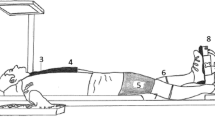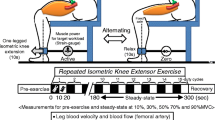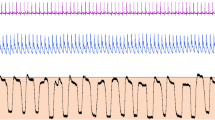Summary
The purpose of this study was to examine the central and peripheral hemodynamic adaptations to maximal leg extension exercise. Seventeen men (¯X=25 years, 84 kg) performed leg extension exercise (Universal equipment) for 12 repetitions (90s) to fatigue. Each repetition consisted of a 3s lifting motion, 1s pause, and 3s lowering motion. Impedance cardiography was used to measure stroke volume (SV), cardiac output (\(\dot V_{{\text{O}}_{{\text{2 max}}} } \)), systolic time intervals, and impedance contractility indices on a beat-by-beat basis. There were significant increases in systolic, diastolic, mean arterial pressure, total peripheral resistance, and HR during exercise. The mean\(\dot Q\) remained similar throughout the protocol. SV decreased even though indices of myocardial performance indicated an enhancement of contractility. The magnitude of\(\dot Q\) and SV were dependent upon the phase of leg extension. SV and\(\dot Q\) during the lifting portions of the exercise were smaller than the lowering portions. The differences in SV and\(\dot Q\) during the concentric and eccentric phases of the exercise most likely reflect the large static forces in exercising muscle which impeded venous return and increased afterload.
Similar content being viewed by others
References
Ahmad M, Blomqvist CG, Mullins CB, Willerson JT (1977) Left ventricular function during lower body negative pressure. Aviat Space Environ Med 48:512–515
Bezucha GR, Lenser MC, Hanson PG, Nagle FJ (1982) Comparison of hemodynamic responses to static and dynamic exercise. J Appl Physiol 53:1589–1593
Bonde-Petersen F, Mark AL, Nielson E (1975) Local muscle blood flow and sustained contractions of human arms and back muscles. Eur J Appl Physiol 34:43–50
Bosisio E, Arosio A, Maudelli V, Sergi M (1980) Ventilatory and pressor response to isometric exercise in normal subjects. Respiration 40:337–343
Bruce RA, Fisher LD, Cooper MN, Gey GO (1974) Separation of effects of cardiovascular disease and age on ventricular function with maximal exercise. Am J Cardiol 34:757–763
Denniston JC, Maher JT, Reeves JT, Cruz JC, Cymerman A, Grover RF (1976) Measurement of cardiac output by electrical impedance at rest and during exercise. J Appl Physiol 40(1):91–95
Edwards RHT, Hill DK, McDonnell MN (1972) Monothermal and intramuscular pressure measurements during isometric contractions of the human quadriceps muscle. J Physiol (Lond) 224:58–59
Frey MAB (1982) Computer-assisted method for performing impedance cardiography calculations. J Appl Physiol 52:274–277
Frey MAB, Doerr BM, Mann BL, Miles DS (1981) Comparison of impedance ventricular function indices with systolic time intervals. Pro IEEE Nat Aerosp Elec Conf. May
Geddes LA, Sadler C (1973) The specific resistance of blood at body temperature. Med Biol Eng 11:336–339
Goldstein DS, Cannon RO III, Zimlichman R, Keiser HR (1986) Clinical evaluation of impedance cardiography. Clin Physiol 6:235–251
Humphreys PW, Lind AR (1963) The blood flow through active and inactive muscles of the forearm during sustained handgrip contractions. J Physiol (Lond) 166:120–135
Kilbom A, Brundin T (1976) Circulatory effects of isometric muscle contractions, performed separately, and in combination with dyanamic exercise. Eur J Appl Physiol 36:7–17
Kitamura K, Jorgensen CR, Gobel FL, Taylor HL, Wang Y (1972) Hemodynamic correlations of myocardial oxygen consumption during upright exercise. J Appl Physiol 32:516–522
Kubicek WG, Patterson RP, Witsoe DA (1970) Impedance cardiography as a non-invasive method of monitoring cardiac function and other parameters of the cardiovascular system. Ann NY Acad Sci (USA) 170:724–732
Lewis RP, Rittgers SE, Forester WF, Boudoulas H (1977) A critical review of systolic time intervals. Circulation 56:146–158
Lewis SF, Snell PG, Taylor WF, Hamra M, Graham RM, Pettinger WA, Blomqvist CG (1985) Role of muscle mass and mode of contraction in circulatory responses to exercise. J Appl Physiol 58:146–151
Lewis SF, Taylor WF, Graham RM, Pettinger WA, Schutte JE, Blomqvist CG (1983) Cardiovascular responses to exercise as functions of absolute and relative work load. J Appl Physiol 54:1314–1323
Lind AR, Taylor SH, Humphreys PW, Kennelly BM, Donald KW (1964) The circulatory effects of sustained voluntary contractions. Cli Sci 27:229–244
Lindquist VAY, Spangler RD, Blount SG (1973) A comparison between the effects of dynamic and isometric exercise as evaluated by the systolic time intervals in normal man. Am Heart J 85:227–236
Longhurst JC, Kelly AR, Gonyea WJ, Mitchell JH (1981) Chronic training with static and dynamic exercise: Cardiovascular adaptation and response to exercise. Circ Res [Suppl I] 48:171–178
MacDougall JD, Tuxen D, Sale DG, Moroz JR, Sutton JR (1985) Arterial blood pressure response to heavy resistance exercise. J Appl Physiol 58:785–790
Miles DS, Sawka MN, Glaser RM, Wilde SW, Doerr BM, Frey MAB (1982) Assessment of central hemodynamics during arm crank exercise. Pro IEEE Natl Aerosp Elec Conf, May
Miles DS, Sawka MN, Hanpeter DE, Foster JE, Doerr BM, Frey MAB (1984) Central hemodynamics during progressive upper and lower body exercise and recovery. J Appl Physiol 57:366–370
Miles DS, Sawka MN, Wilde SW, Doerr BM, Frey MAB, Glaser RM (1981) Estimation of cardiac output by electrical impedance during arm exercise in women. J Appl Physiol 51:1488–1492
Riendl AM, Gotshall RW, Reinke JA, Smith JS (1977) Cardiovascular response of human subjects to isometric contraction of large and small muscle groups. Pro Soc Exp Bio Med 154:171–174
Sarnoff SJ, Braunwald E, Welch Jr, GH, Case RB, Stainsby WH, Macruz R (1958) Hemodynamic determinants of oxygen consumption of the heart with special reference to the tension time index. Am J Physiol 192:148–156
Sejersted OM, Hargens AR, Kordel KR, Blom P, Jensen O, Hermansen L (1984) Intramuscular fluid pressure during isometric contraction of the human skeletal muscle. J Appl Physiol 56:287–295
Stefadouros MA, Grossman W, Shahawy ME, Witham AC (1974) The effect of isometric exercise on the left ventricular volume in man. Circulation 1185–89
Teo K-K, Hetherington MD, Haennel RG, Greenwood PV, Rossall RE, Kappagoda T (1985) Cardiac output measured by impedance cardiography during maximal exercise tests. Cardiovas Res 19:737–743
Van Fraechem JHP (1979) Stroke volume and systolic time interval adjustments during bicycle exercise. J Appl Physiol 46:588–592
Author information
Authors and Affiliations
Rights and permissions
About this article
Cite this article
Miles, D.S., Owens, J.J., Golden, J.C. et al. Central and peripheral hemodynamics during maximal leg extension exercise. Europ. J. Appl. Physiol. 56, 12–17 (1987). https://doi.org/10.1007/BF00696369
Accepted:
Issue Date:
DOI: https://doi.org/10.1007/BF00696369




